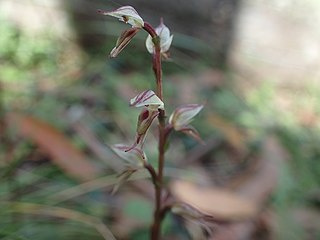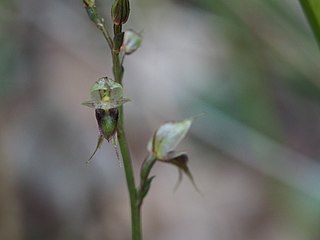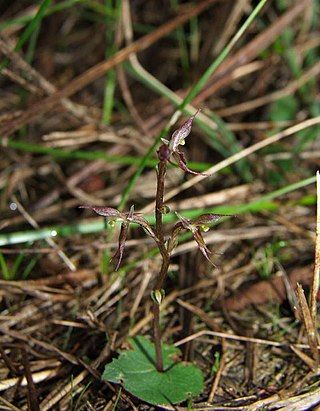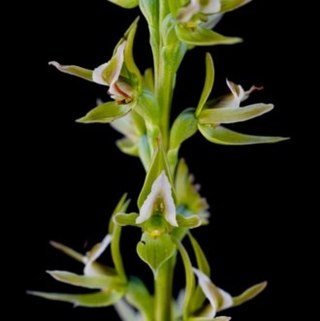
Acianthus, commonly known as mosquito orchids, is a genus of about twelve species of plants in the orchid family, Orchidaceae. Mosquito orchids are terrestrial herbs with a single, heart-shaped, usually ground-hugging leaf and one to many small, green, pinkish or purplish flowers on a fleshy stalk. They are found in New Caledonia, Australia and New Zealand.

Acianthus fornicatus, commonly known as bristly mosquito orchid or pixie caps, is a species of flowering plant in the orchid family Orchidaceae and is endemic to eastern Australia. It is a terrestrial herb with a single, heart-shaped leaf and up to ten translucent pinkish-red flowers, and is widespread and common in coastal and near-coastal areas.

Acianthus apprimus, commonly known as early mosquito orchid, is a species of flowering plant in the orchid family Orchidaceae and is endemic to New South Wales in Australia. It is a terrestrial herb with a single, heart-shaped leaf and between two and nine translucent pinkish flowers with reddish markings and is found in disjunct populations around the state.

Acianthus collinus, commonly known as hooded mosquito orchid or inland mosquito orchid, is a species of flowering plant in the orchid family Orchidaceae and is endemic to south-eastern continental Australia. It is a terrestrial herb with a single, heart-shaped leaf and between two and nine translucent pinkish flowers with reddish markings and is found growing in colonies on sheltered slopes in open forest in on the western slopes of the Great Dividing Range.

Acianthus exiguus, commonly known as tiny mosquito orchid, is a flowering plant in the orchid family Orchidaceae and is endemic to New South Wales in Australia. It is a terrestrial herb with a single, heart-shaped leaf and up to five translucent greenish-white flowers with pinkish markings and is found growing in forests on the north coast of the state.

Acianthus exsertus, commonly known as gnat orchid or large mosquito orchid, is a species of flowering plant in the orchid family Orchidaceae and is endemic to eastern Australia. It is a terrestrial herb with a single, heart-shaped leaf and up to 25 small, fine, dark brown flowers with pinkish and purplish markings and is found growing in sheltered places in forests in Queensland, New South Wales the ACT and Victoria.

Acianthus pusillus, commonly known as small mosquito orchid, is a species of flowering plant in the orchid family Orchidaceae and is endemic to eastern Australia. It is a terrestrial herb with a single, heart-shaped leaf and up to 18 small, translucent green or pinkish flowers with reddish marking and a green to reddish-purple labellum. It is widely distributed, growing in moist places from central-eastern Queensland, south through New South Wales and Victoria to South Australia and Tasmania.
Caladenia saxatilis is a plant in the orchid family Orchidaceae and is endemic to South Australia. It is a ground orchid with a single hairy leaf and one or two pale creamy-green flowers, sometimes with thin reddish lines. It occurs in the southern Flinders Ranges.

Pterostylis bicolor, commonly known as the black-tip greenhood, is a plant in the orchid family Orchidaceae and is endemic to south-eastern Australia. It has a rosette of leaves and when flowering, three to ten well-spaced, bright green flowers with a blunt, greenish-black appendage on the labellum. It is similar to the swan orchid, Pterostylis cycnocephala but that species has a beak-like appendage and crowded flowers.
Pterostylis anaclasta is a species of flowering plant in the orchid family Orchidaceae and is endemic to a restricted part of Queensland. It has a rosette of about 6 sessile leaves and about 4 transparent white flowers with bright reddish lines and markings, a reddish brown labellum with white hairs, and lateral sepals strongly turned backwards.

Prasophyllum montanum, commonly known as the mountain leek orchid, is a species of orchid endemic to eastern Australia. It has a single tubular, green leaf and up to fifty scented, greenish to pinkish flowers. It grows in montane ecosystems at altitudes above 1,500 m (5,000 ft).
Prasophyllum campestre, commonly known as the sandplain leek orchid, or inland leek orchid, is a species of orchid endemic to eastern Australia. It has a single tubular, yellowish-green leaf and up to twenty greenish, strongly scented flowers with red, purplish, brown or white marks. It grows in the drier parts of Queensland, New South Wales and Victoria.
Prasophyllum exile is a species of orchid endemic to a relatively small area of eastern Australia. It has a single tubular, green leaf and up to ten scented, green or purplish-brown and white flowers with a white labellum. It is similar to P. brevilabre and was formerly treated as a slender form of that species with fewer, more well-spaced flowers.

Prasophyllum caudiculum, commonly known as the Guyra leek orchid, is a species of orchid endemic to a small area of northern New South Wales. It has a single tubular, bright green leaf and up to thirty five greenish to reddish-brown flowers crowded along an erect flowering stem. It grows in grassy places near Guyra.

Acianthus caudatus, commonly known as mayfly orchid, is a species of flowering plant in the orchid family Orchidaceae and is endemic to eastern Australia. It is a terrestrial herb with a single egg-shaped or heart-shaped leaf and up to nine dark purplish flowers with thin, spreading sepals and petals, often with a musty odour.
Genoplesium pedersonii, commonly known as Pederson's midge orchid, is a species of small terrestrial orchid endemic to the Blackdown Tableland in Queensland. It has a single thin leaf fused to the flowering stem and up to thirty small, greenish red to reddish, self-pollinating flowers with a dark purplish red labellum. The species is treated as Corunastylis pedersonii in Queensland.
Corybas expansus, commonly known as the flared helmet orchid or dune helmet orchid is a species of terrestrial orchid that is endemic to South Australia. It has a heart-shaped to more or less round leaf and a single purplish flower with greenish or transparent areas.
Corybas limpidus, commonly known as the crystal helmet orchid, is a species of terrestrial orchid endemic to Western Australia. It has round or heart-shaped leaf and a translucent greenish flower with dark red or burgundy-coloured spots and blotches. The edges of the labellum have a few short, blunt teeth.

Acianthus cuneatus, commonly known as New England mosquito orchid, is a species of flowering plant in the orchid family Orchidaceae and is endemic to the Northern Tablelands of New South Wales. It is a terrestrial herb with a single, heart-shaped leaf and up to seven translucent greenish flowers with purplish stripes and is found growing in sheltered slopes in open forest.
Acianthus ledwardii was a species of flowering plant in the orchid family Orchidaceae and was endemic to Queensland in Australia but is now presumed extinct. It was a terrestrial herb with a single, heart-shaped leaf and between 2 and 6 transparent, reddish brown flowers.












